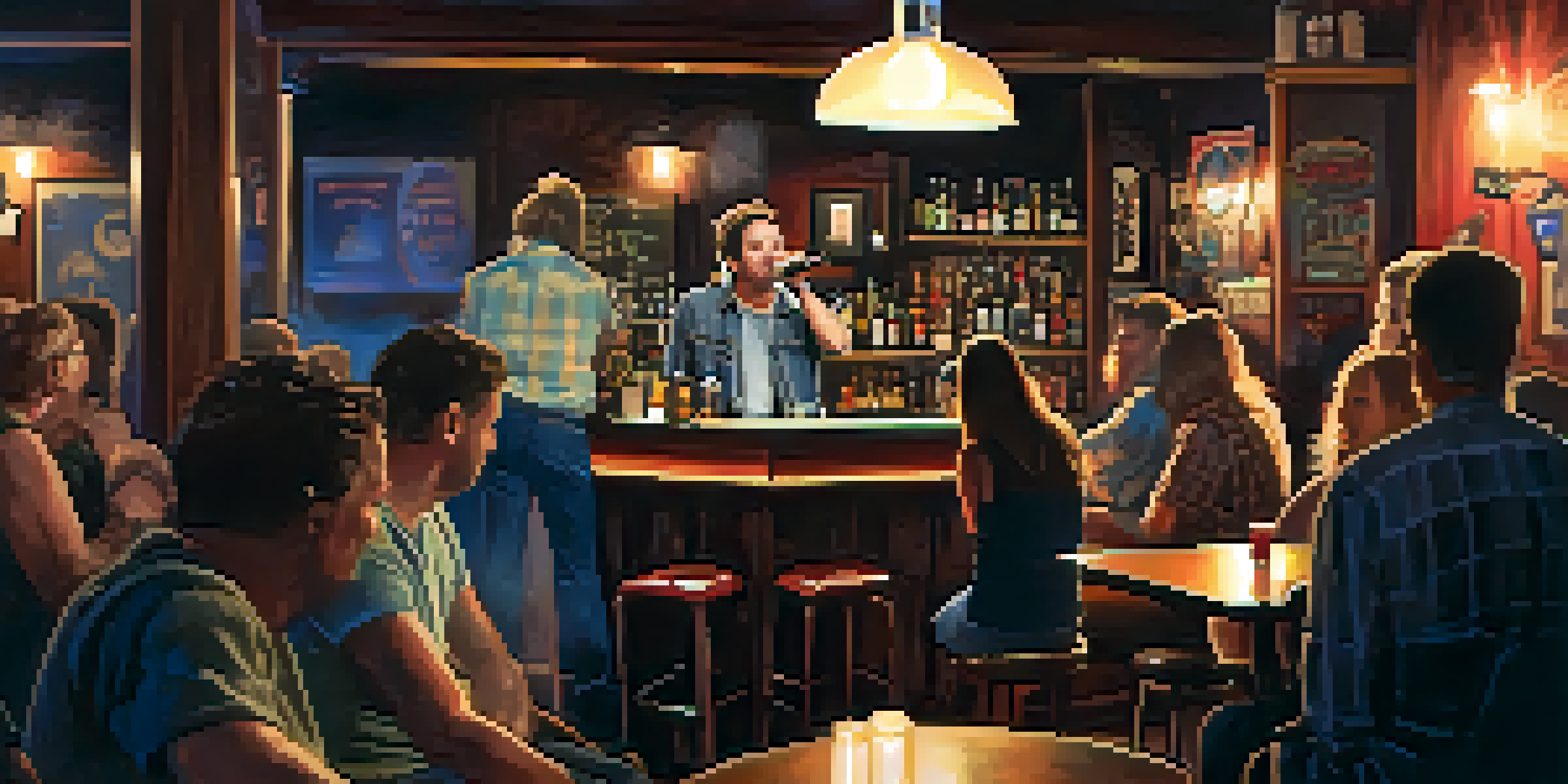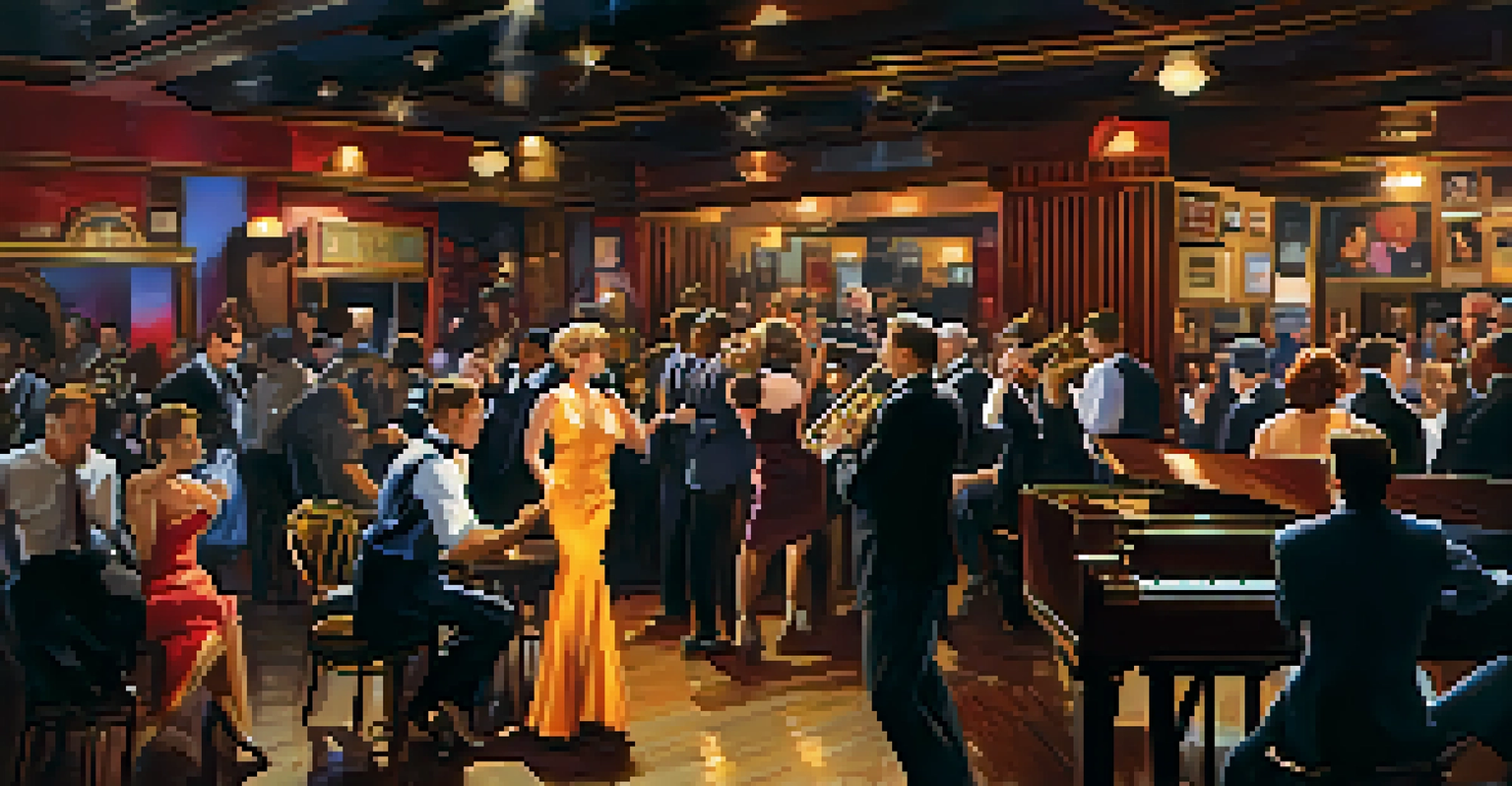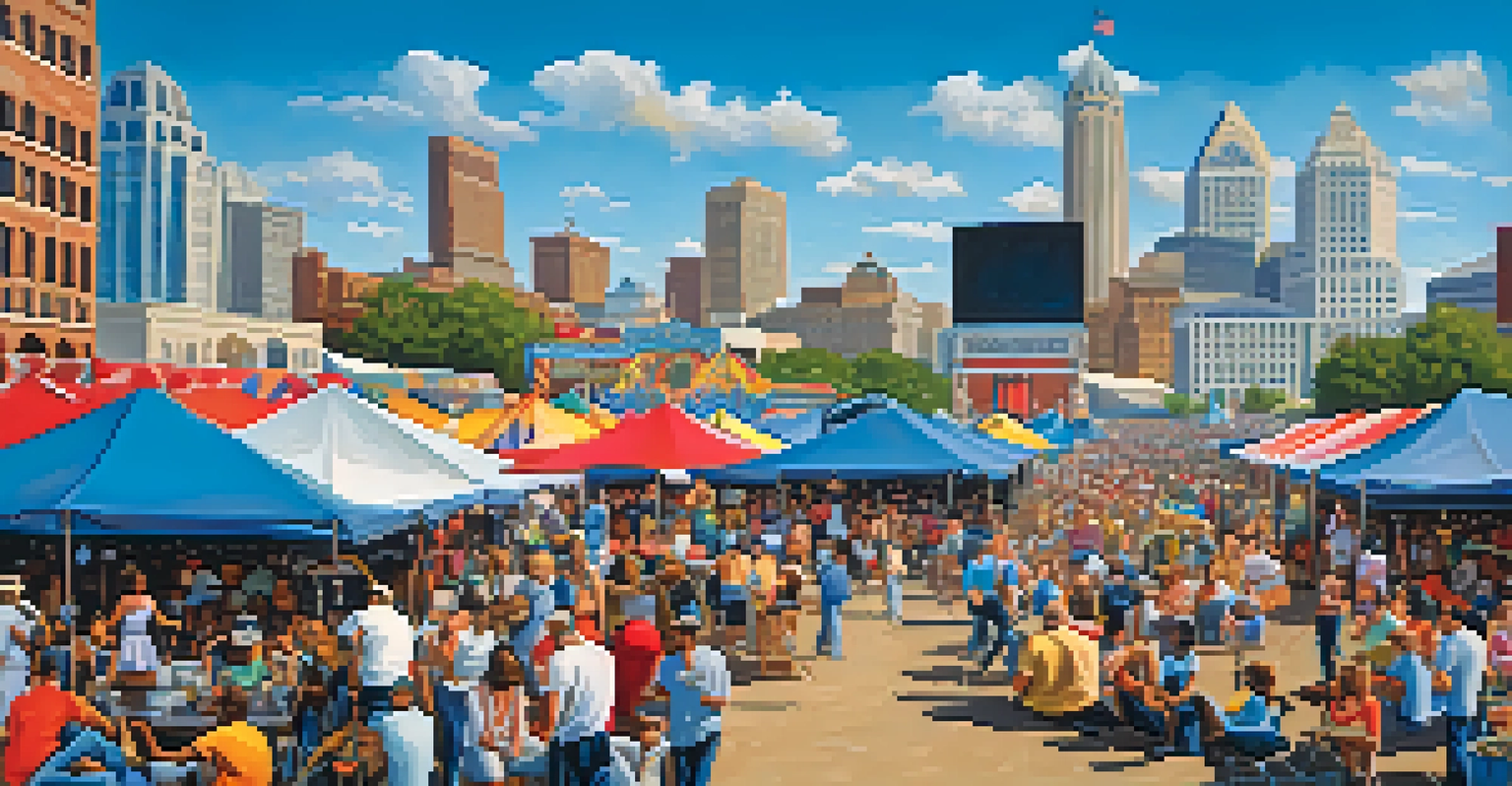Missouri's Role in the Development of Jazz and Blues

The Birthplace of Blues: St. Louis and Kansas City
Missouri has long been recognized as a cradle for blues music, particularly in cities like St. Louis and Kansas City. These urban centers became melting pots for diverse musical influences, where African American communities blended folk traditions with new styles. The rich cultural fabric of the region allowed blues to flourish, echoing the experiences and struggles of its creators.
The blues is a simple, but deep music. It can be a joyful sound or a cry of despair, but it always tells a story.
In St. Louis, the blues scene began to take shape in the early 20th century, with musicians performing in bars and clubs along the famous Washington Avenue. This vibrant atmosphere birthed legendary artists such as Walter Davis and Peetie Wheatstraw, who helped define the genre. Their music often reflected the everyday lives of working-class individuals, making it relatable and heartfelt.
Kansas City, on the other hand, became a hub for jazz and blues, with its distinctive style emerging from the influence of ragtime and swing. The city's famous 18th and Vine district was home to iconic venues like the Blue Room, where legends like Count Basie and Jay McShann honed their craft. This rich history highlights Missouri's integral role in shaping the evolution of these genres.
Influential Artists and Their Impact
Missouri has produced a remarkable number of influential artists who have left an indelible mark on jazz and blues music. One standout figure is Chuck Berry, born in St. Louis, who revolutionized rock and roll with his guitar riffs and storytelling lyrics. His unique blend of blues and rhythm and blues laid the groundwork for future generations of musicians.

Another pivotal artist, Sarah Vaughan, hailing from Kansas City, brought a powerful vocal style that transcended jazz. Her ability to convey emotion through her voice inspired countless singers, making her a beloved figure in both jazz and blues circles. Vaughan's career exemplifies how Missouri artists have continually pushed the boundaries of these genres.
Missouri's Musical Heritage
Missouri, particularly St. Louis and Kansas City, has played a pivotal role in the evolution of jazz and blues, blending diverse influences and fostering iconic artists.
Moreover, the legacy of these musicians continues to influence contemporary artists, creating a lasting connection between Missouri's musical past and present. As newer generations draw inspiration from their predecessors, the state remains a vital source of creativity and innovation in the music world.
The Role of Clubs and Venues in Musical Evolution
The clubs and venues in Missouri served as essential platforms for budding musicians to showcase their talents. In cities like St. Louis and Kansas City, local establishments hosted live performances, allowing artists to connect with audiences and hone their craft. These intimate settings fostered a sense of community and collaboration among musicians.
Jazz is the only music genre that has been developed in America. It is a reflection of the cultural heritage of African Americans and a celebration of their struggles and triumphs.
One notable venue is the historic Blue Note in Columbia, which has attracted both local and national acts since the 1980s. It has played a crucial role in promoting jazz and blues, providing a space for artists to experiment and innovate. The welcoming atmosphere encourages dialogue between performers and fans, creating a vibrant music scene.
These venues not only supported established artists but also nurtured emerging talent. Open mic nights and jam sessions allowed newcomers to step into the spotlight, ensuring the continuation of Missouri's rich musical legacy. This cycle of support and growth is vital to the ongoing evolution of jazz and blues in the state.
Cultural Influences: African American Heritage
At the heart of Missouri's contribution to jazz and blues lies its deep African American heritage. The struggles and triumphs of this community have shaped the themes and melodies of these genres, reflecting a rich tapestry of history. Music became a powerful outlet for storytelling, allowing artists to share their experiences and connect with listeners on a profound level.
The Great Migration saw many African Americans relocating to cities like St. Louis and Kansas City in search of better opportunities. This influx of talent and culture created a dynamic environment where blues and jazz could thrive. The blending of various musical traditions, including gospel and folk, enriched the soundscape, leading to the creation of unique sub-genres.
Impact of Venues on Artists
Clubs and venues in Missouri have been essential for musicians, providing platforms for live performances that help nurture talent and build community.
Today, the influence of African American culture on jazz and blues continues to resonate. Festivals, museums, and educational programs celebrate this heritage, inviting new audiences to appreciate the roots of these beloved genres. The ongoing exploration of these cultural influences ensures that the stories of the past remain alive in contemporary music.
Missouri's Jazz and Blues Festivals: A Celebration
Missouri hosts a vibrant array of jazz and blues festivals that celebrate its musical heritage and bring together artists and fans alike. Events such as the Kansas City Jazz Festival and the St. Louis Blues Festival showcase both local talent and renowned musicians, creating a lively atmosphere. These gatherings not only honor the past but also foster a sense of community among music lovers.
At these festivals, attendees are treated to a diverse lineup of performances, workshops, and jam sessions. Fans can immerse themselves in the rhythms and sounds that have defined Missouri's musical landscape while discovering new artists. It's a unique opportunity to experience the energy and creativity that permeate the state's jazz and blues scenes.
Moreover, these festivals play a crucial role in supporting local economies, attracting visitors from across the country. They provide a platform for musicians to gain exposure and connect with industry professionals, ensuring the continued growth of Missouri's music scene. The celebration of jazz and blues in the state reflects a deep cultural appreciation that resonates with everyone who attends.
Preserving the Legacy: Museums and Archives
To honor Missouri's rich musical history, several museums and archives have been established to preserve the legacy of jazz and blues. Institutions like the National Blues Museum in St. Louis offer visitors an in-depth look at the genre's evolution, showcasing artifacts, exhibits, and interactive experiences. These resources play a crucial role in educating the public about the significance of blues in American culture.
The American Jazz Museum in Kansas City is another vital establishment that highlights the city's contributions to the genre. Featuring exhibits on legendary artists, live performances, and educational programs, it serves as a hub for jazz enthusiasts. These museums not only preserve history but also inspire future generations of musicians and fans.
Celebration of Jazz and Blues
Missouri hosts numerous jazz and blues festivals that not only celebrate musical heritage but also support local economies and connect artists with audiences.
In addition to physical spaces, digital archives and initiatives are emerging to ensure that the stories of jazz and blues remain accessible. By digitizing recordings, photographs, and personal stories, these projects allow a broader audience to engage with the music's history. This commitment to preservation ensures that Missouri's influence on jazz and blues continues to be celebrated for years to come.
The Future of Jazz and Blues in Missouri
As we look to the future, Missouri's jazz and blues scenes show no signs of slowing down. With a wealth of talent emerging from local schools, universities, and community programs, the state remains a breeding ground for innovation in these genres. Aspiring musicians are not only keeping the traditions alive but also infusing them with new influences and styles.
Technology also plays a significant role in shaping the future of jazz and blues. With the rise of streaming platforms and social media, artists can reach global audiences, sharing their music and stories with fans far beyond Missouri's borders. This accessibility opens up exciting opportunities for collaboration and exploration within the music community.

Ultimately, the future of jazz and blues in Missouri is bright, marked by a commitment to honoring the past while embracing new possibilities. As artists continue to push boundaries and experiment with their craft, the state will undoubtedly remain a vital hub for these beloved genres. The legacy of jazz and blues in Missouri is not just history; it's an ongoing journey of creativity and expression.